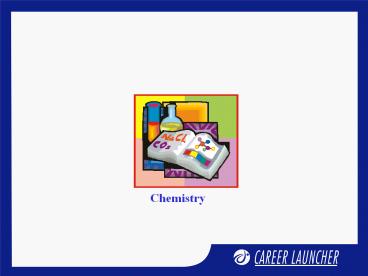Enthalpy - PowerPoint PPT Presentation
1 / 32
Title:
Enthalpy
Description:
Title: Enthalpy Author: salim Last modified by: JB Created Date: 8/21/2003 6:50:14 AM Document presentation format: On-screen Show Company: Career Launcher – PowerPoint PPT presentation
Number of Views:184
Avg rating:3.0/5.0
Title: Enthalpy
1
(No Transcript)
2
Alkenes
3
Session objectives
- Kolbes method
- Dehydration of alcohol
- Dehydrohalogenation
- Miscellaneous method
4
General characteristics of alkene
- Olefins
- General molecular formula CnH2n
- CC bond hybridization 1.34 A0
- sp2 hybridization
- Show chain, positional and geometrical isomerism
5
General characteristics of alkene
Chain isomerism
Positional isomerism
1-pentene
2-pentene
6
General characteristics of alkene
Geometric isomerism
7
Preparation of alkenes
The Kolbes electrolysis
8
Dehydration of alcohols
(E1 - elimination)
1-butene
9
Mechanism
Oxonium ion
Carbocation
10
Features of dehydration
- A carbocation is formed as an intermediate.
- The ease of dehydration of alcohols is 3 gt 2 gt
1
- 3 carbocation is most stable
gt
gt
30
20
10
11
Features of dehydration
The stability of alkenes is governed by
Saytzeffs rule
12
Features of dehydration
Dehydrohalogenation of alkyl halides (E2 or
1,2-elimination or -elimination)
Mechanism
13
Features of dehydration
- Stereochemically, the best conformation for
elimination is the anti-coplanar conformation,
i.e. the three bonds HC, CC and CBr are in one
plane.
- There is no formation of any intermediate in this
reaction, rather it proceeds through a
transition state.
- A trans- or anti- elimination in which the atoms
leave from the opposite sides is observed in most
cases
- The reaction is thus stereospecific, since a base
pulls a hydrogen, a strong base will accelerate
E2 elimination.
- predominant formation of a substituted alkene is
formed according to Saytzeffs rule
14
Features of dehydration
15
Hoffmans elimination
If the leaving group is very strong
electron-attracting, then elimination takes place
contrary to Saytzeffs rule. The formation of a
less substituted alkene is observed.
16
Hoffmans elimination
17
Miscellaneous Methods
Debromination of vicinal dibromides
18
Miscellaneous Methods
Corey-House method
Wittig reaction
19
Miscellaneous Methods
Catalytic dehydrogenation
20
(No Transcript)
21
Class Exercise - 1
Solution
Wittig reaction.
Hence, the answer is (b).
22
Class Exercise - 2
Solution
CH2 CH CH CH2
Hence, the answer is (c).
23
Class Exercise - 3
Solution
sp2, sp3 from the structure.
Hence, the answer is (a).
24
Class Exercise - 4
When an aqueous solution of sodium acetate and
sodium propionate is electrolyzed, one gets (a)
ethane (b) propane (c) butane (d) All of
these
Solution
Along with normal butane we get unwanted product
like ethane, propane, etc.
Hence, the answer is (d).
25
Class Exercise - 5
Which has the least heat of hydrogenation? (a)
1, 3-butadiene (b) 1-butene (c)
Trans-2-butene (d) Cis-2-butene
Solution
trans-2-butene is maximum stable. Therefore, heat
of hydrogenation will be least.
Hence, the answer is (c).
26
Class Exercise - 6
Solution
3,3-dimethyl but-1-ene
Hence, the answer is (b).
27
Class Exercise 7
Which of the following is a false statement? (a)
There is sp3 hydridization in propane(b) Ethyne
has a linear structure(c) There is sp2
hybridization in ethylene(d) Alkynes show
geometric isomerism
Solution
Alkynes do not show geometrical isomerism because
it is a linear structure.
Hence, the answer is (d).
28
Class Exercise - 8
Which of the following types of isomerism is not
exhibited by alkenes?(a) Position
isomerism (b) Chain isomerism(c) Geometric
isomerism (d) Metamerism
Solution
Metamerism will not be shown by alkenes.
Hence, the answer is (d).
29
Class Exercise - 9
Solution
No hyperconjugation.
Hence, the answer is (c).
30
Class Exercise 10
31
Solution
32
(No Transcript)































